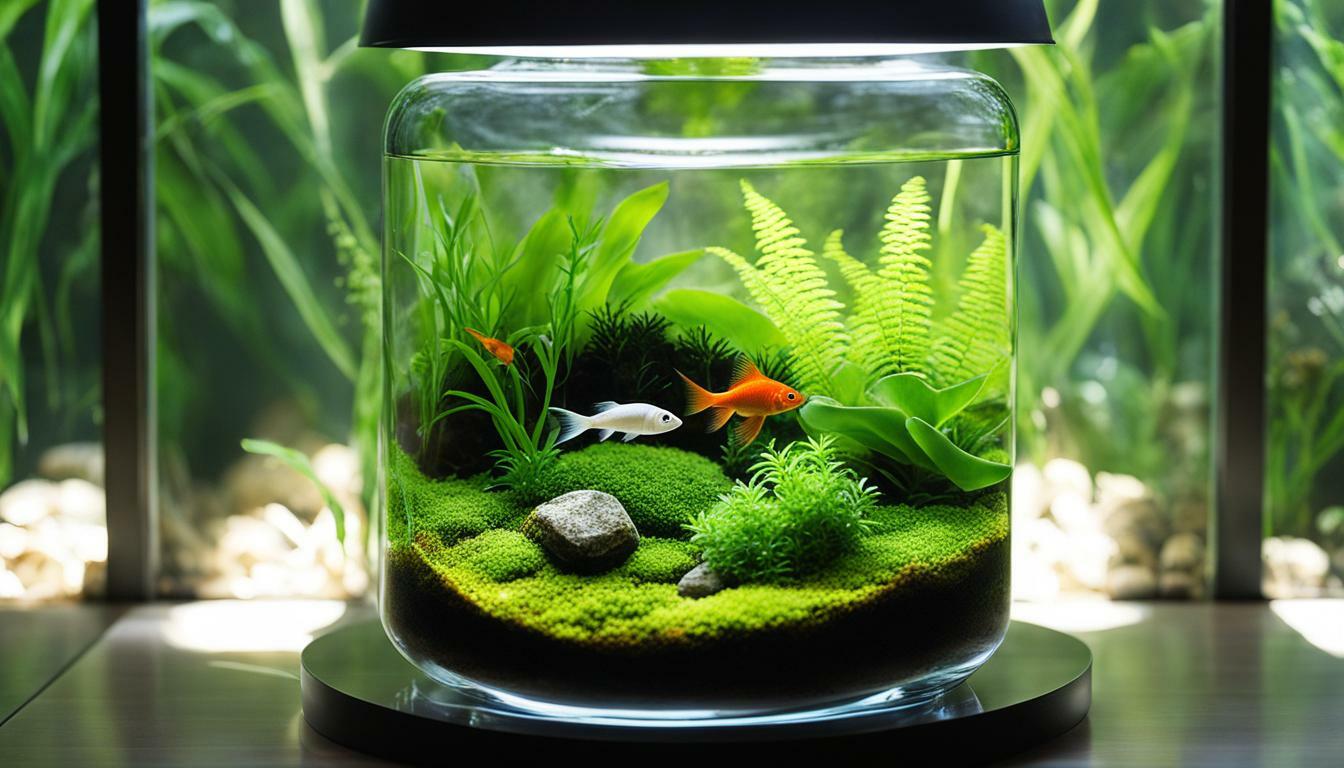Aquatic terrariums offer a unique opportunity to create a thriving underwater ecosystem in the comfort of your own home. Whether you’re a beginner or an experienced enthusiast, the setup and maintenance of these mesmerizing habitats can be a rewarding and educational experience.
Key Takeaways:
- There are different types of aquatic terrariums, including fish tank terrariums, houseplant planters, and desert terrariums.
- Setting up a tropical terrarium requires careful consideration of components such as the container, background, drainage layer, and substrate.
- Choosing the right fish tank terrarium plants, such as ferns, vines, foliage, and moss, is crucial for creating a vibrant underwater landscape.
- Proper lighting is essential for the health and growth of aquatic terrarium plants, and options include aquarium lighting and utilizing natural sunlight.
- Regular maintenance, including water changes, cleaning, temperature control, and plant care, is necessary to ensure the longevity of your aquatic terrarium.
Different Types of Aquatic Terrariums
From fish tank terrariums to vivariums, there are several types of aquatic terrariums to choose from depending on your preferences. Each type offers a unique environment for plants, animals, or a combination of both. Let’s explore some of the popular options:
Fish Tank Terrarium
A fish tank terrarium is a classic choice for aquatic enthusiasts. It combines the beauty of underwater plants and fish, creating a serene and captivating display. With the right selection of fish tank terrarium plants, such as ferns, vines, foliage, and moss, you can create a vibrant and natural underwater ecosystem.
Houseplant Planter
If you prefer a more integrated approach, a houseplant planter can be a great choice. This type of terrarium combines the beauty of aquatic plants with houseplants, creating a stunning and unique display. By placing the planter in a well-lit area, you can enjoy the benefits of both types of plants in one container.
Desert Terrarium
For those who prefer a different aesthetic, a desert terrarium offers a striking contrast to traditional aquatic setups. It features arid landscape elements such as sand, rocks, and succulent plants. With proper care and maintenance, a desert terrarium can thrive and bring the beauty of the desert into your space.
Tropical Terrarium
A tropical terrarium is an excellent choice for those who want to recreate a lush, jungle-like environment. It typically includes a variety of plant species, creating a dense and vibrant ecosystem. With the addition of hardscape elements like driftwood and rocks, you can create a natural and visually appealing underwater paradise.
Vivarium and Paludarium
A vivarium, also known as a paludarium, combines terrestrial and aquatic elements to create a unique habitat for amphibians, reptiles, or other small animals. With carefully selected plants and the right balance of land and water, you can create a mini-ecosystem that mimics a specific natural habitat.
Whether you prefer the serene beauty of a fish tank terrarium or the exotic allure of a tropical environment, there’s an aquatic terrarium to suit your tastes. By choosing the right type and following the proper setup and maintenance guidelines, you can create a captivating underwater ecosystem to enjoy in your home or office.
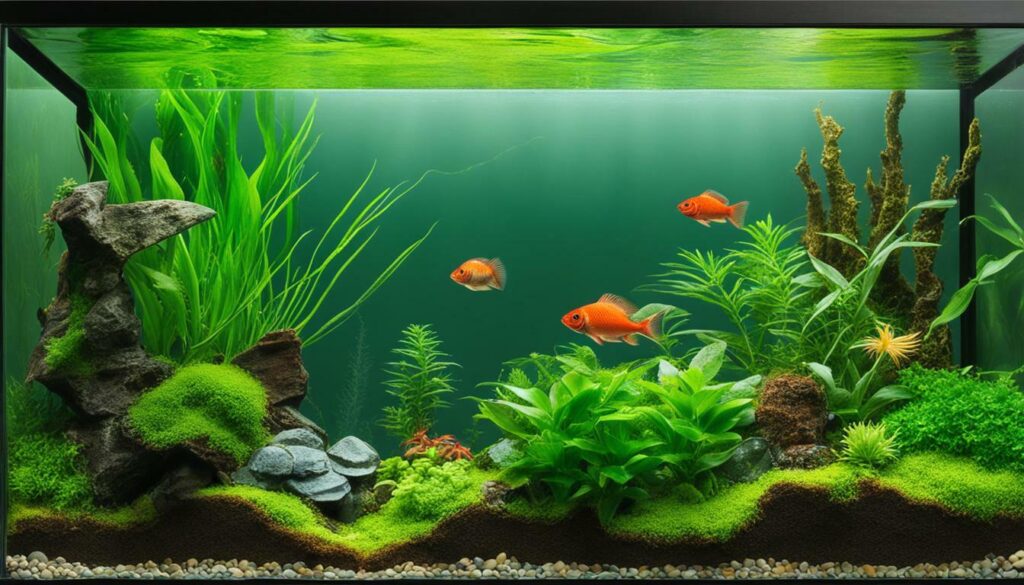
| Type of Aquatic Terrarium | Main Features |
|---|---|
| Fish Tank Terrarium | Combines underwater plants and fish |
| Houseplant Planter | Integrates aquatic plants with houseplants |
| Desert Terrarium | Features arid landscape elements and succulent plants |
| Tropical Terrarium | Recreates a lush jungle-like environment |
| Vivarium and Paludarium | Combines terrestrial and aquatic elements for amphibians or reptiles |
Setting up a Tropical Terrarium
Creating a tropical terrarium requires careful planning and attention to detail in order to provide the ideal environment for your aquatic plants and fish. To start, you’ll need an aquarium container that is large enough to accommodate your desired plants and fish. The container should be made of glass to provide optimal visibility and a suitable seal to prevent water leakage.
Once you have your container, it’s time to set up the background. You can either choose a pre-made background or create your own using materials like foam, epoxy, and aquarium-safe paint. The background adds depth and visual interest to the terrarium, mimicking the natural habitat of your aquatic plants and fish.
The next step is to create a drainage layer at the bottom of the terrarium. This layer allows excess water to drain away from the plant roots, preventing waterlogged soil and potential root rot. A popular option for the drainage layer is using small pebbles or aquarium gravel.
After the drainage layer, add substrate to the terrarium. The substrate provides a nutrient-rich foundation for your plants to grow. Choose a substrate that is specifically formulated for aquatic terrariums and is suitable for the types of plants you’ll be incorporating. Consider adding hardscape elements such as driftwood and rocks to create a natural-looking environment for your aquatic plants and fish.
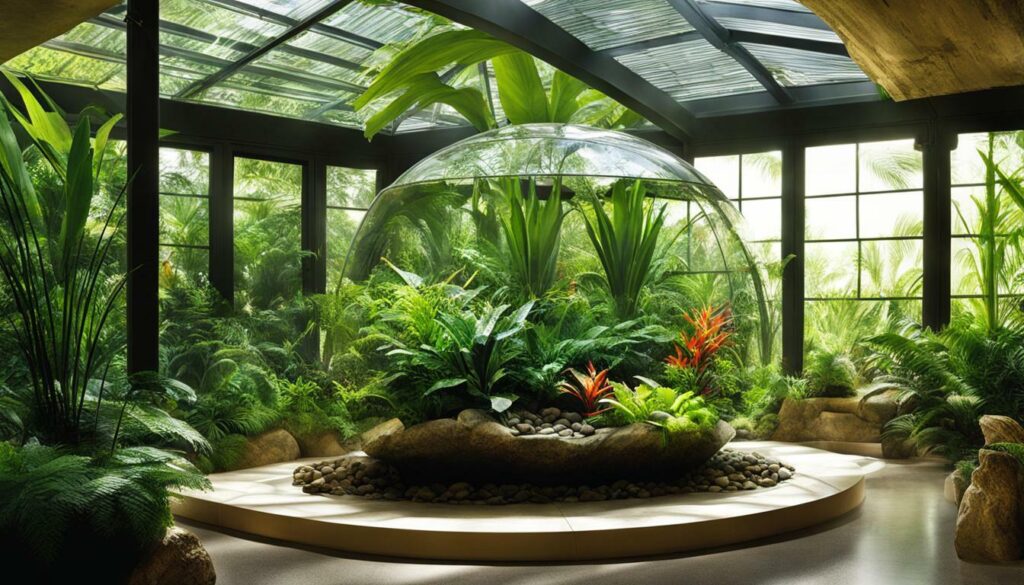
| Fish Tank Terrarium Plants | Lighting Solution |
|---|---|
| Ferns | LED lights |
| Vines | Aquarium lighting |
| Foliage | Natural sunlight |
| Moss |
When it comes to selecting fish tank terrarium plants, consider options such as ferns, vines, foliage, and moss. These plants thrive in high humidity and low-light conditions, making them perfect for a tropical terrarium. Ensure they are suitable for an aquatic environment and arrange them strategically within your terrarium to create a lush and visually appealing landscape.
Choosing the right lighting solution is essential for the health and growth of your aquatic plants. LED lights are a popular choice as they provide the necessary spectrum for plant photosynthesis. Alternatively, you can also use aquarium lighting or take advantage of natural sunlight. Consider the needs of your specific plants when deciding on the lighting solution.
Example H3 Heading (if relevant)
“Creating a tropical terrarium is a rewarding experience that allows you to observe the beauty of nature in your own home,” says marine biologist Dr. Emily Collins. “By carefully selecting the right plants, creating a suitable environment, and providing adequate lighting, you can create a thriving underwater ecosystem that brings tranquility and natural beauty to any space.”
With a well-constructed tropical terrarium in place, you can enjoy the beauty of your aquatic plants and the soothing presence of swimming fish. Keep in mind that maintaining a tropical terrarium requires regular monitoring of water quality, temperature control, and plant care to ensure the longevity and health of your underwater ecosystem.
Remember, each terrarium is unique, and it may take some trial and error to find the perfect balance of plants, light, and maintenance for your individual setup. But with patience and dedication, you can create a captivating aquatic terrarium that brings a touch of nature into your home.
Selecting Fish Tank Terrarium Plants
When it comes to selecting plants for your fish tank terrarium, there is a wide variety to choose from, each offering its own unique benefits. The right combination of plants can create a stunning underwater landscape, providing both aesthetic appeal and a healthy environment for your aquatic pets.
Ferns are a popular choice for fish tank terrariums due to their ability to thrive in moist environments. They come in various sizes and leaf shapes, such as the Boston Fern or the Water Fern, adding texture and depth to your terrarium. Vines, such as the Hornwort or Java Moss, are excellent options for adding vertical interest and creating a natural habitat for your fish. Their trailing nature provides hiding spots and extra surface area for beneficial bacteria to grow.
Foliage plants, like the Anubias or the Amazon Sword, can bring vibrant colors and provide shelter for your fish. These plants can tolerate lower light conditions and are easy to care for, making them ideal for beginners. Moss, such as Christmas Moss or Java Moss, can be used to create lush carpets or attach to driftwood and rocks to mimic natural environments.
Remember that the compatibility between your chosen plants and fish is vital. Some plants may be nibbled on by certain species, while others may require specific water conditions to thrive. Do your research and consult with an expert to ensure a harmonious balance in your fish tank terrarium.
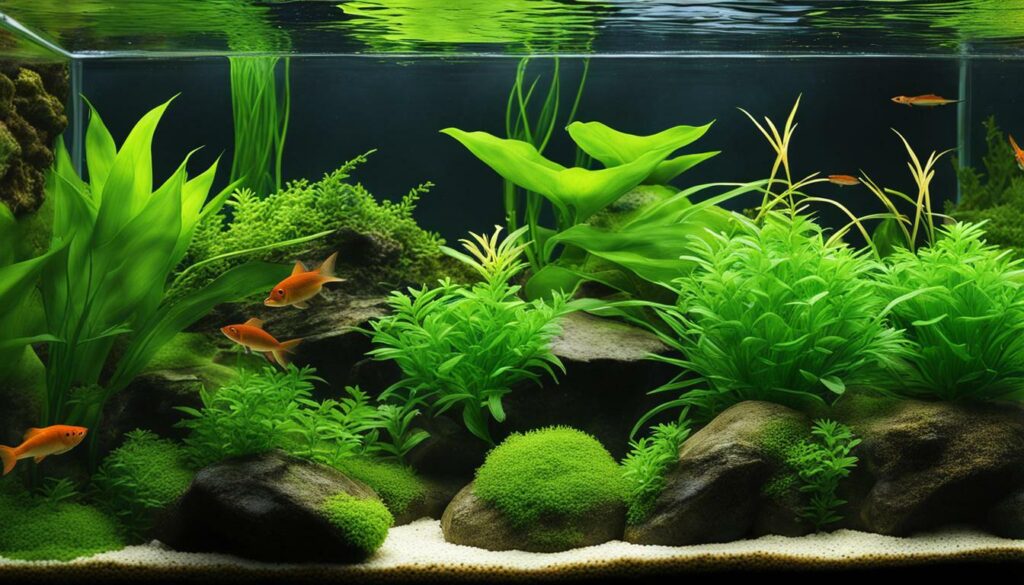
| Plant Name | Benefits |
|---|---|
| Boston Fern | Provides lush green foliage |
| Hornwort | Adds vertical interest and provides hiding spots |
| Anubias | Offers vibrant colors and provides shelter |
| Java Moss | Creates lush carpets and attaches to driftwood |
Now that you have a better understanding of the different types of fish tank terrarium plants available, you can begin creating a beautiful and thriving aquatic environment.
Creating the Perfect Lighting Solution
Providing the right amount of light is crucial for the health and growth of your aquatic plants in a terrarium. Proper lighting not only ensures photosynthesis but also enhances the overall aesthetic appeal of your underwater ecosystem. There are various options to consider when it comes to lighting solutions for your aquatic terrarium.
One popular choice is aquarium lighting, which is specifically designed for underwater environments. LED lights are highly recommended for their energy efficiency and versatility. They offer a wide range of color options, allowing you to create a customized lighting experience. LED lights also emit minimal heat, preventing the risk of overheating your terrarium.
Another option is natural sunlight. If you have a well-lit room with plenty of indirect sunlight, you can position your aquatic terrarium near a window. However, be cautious of direct sunlight exposure as it can lead to excessive heat and promote algae growth. Finding the right balance between natural and artificial lighting is essential for maintaining a healthy and thriving aquatic terrarium.
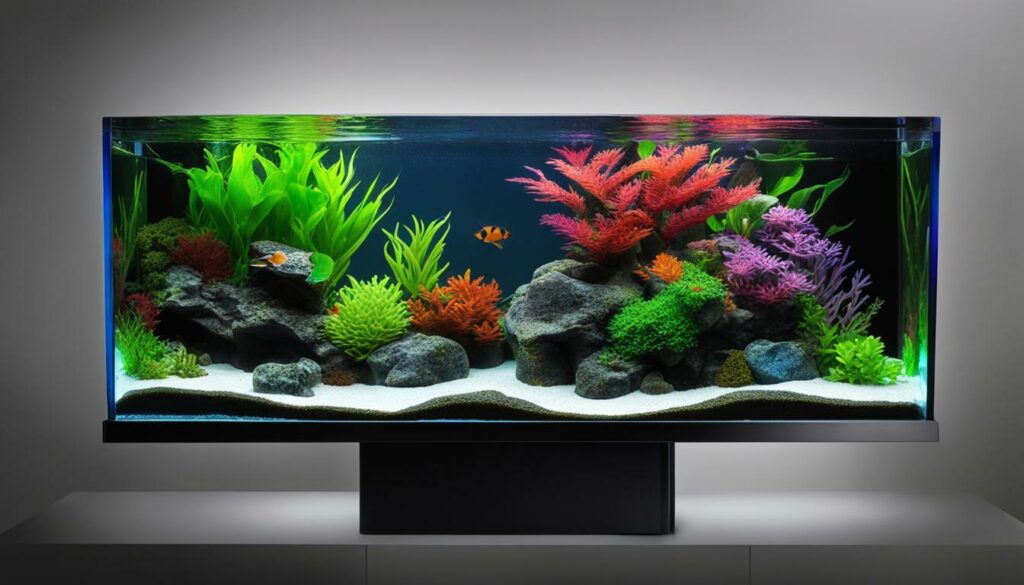
To ensure adequate lighting, it is recommended to use a combination of sources in your aquatic terrarium. For example, you can use LED lights as the primary light source and supplement it with natural sunlight during the day. This way, you provide a balanced spectrum of light for your plants and mimic their natural habitat.
| Light Source | Advantages | Disadvantages |
|---|---|---|
| Aquarium Lighting | – specifically designed for underwater environments – energy-efficient LED options – customizable colors | – may require additional equipment – initial setup costs |
| Natural Sunlight | – provides a natural spectrum of light – can be cost-effective – enhances overall aesthetics | – potential for excessive heat – may cause algae growth – limited control over intensity and duration |
“Proper lighting not only ensures photosynthesis but also enhances the overall aesthetic appeal of your underwater ecosystem.”
When it comes to the duration of lighting, aim for approximately 8 to 12 hours per day. This aligns with the natural day-night cycle and allows your plants to receive the necessary light for growth. It is important to monitor the temperature within your terrarium and adjust the lighting duration accordingly to prevent overheating.
Remember, each aquatic terrarium is unique, and the lighting requirements may vary depending on the specific plants and animals you choose to incorporate. Pay attention to your plants’ response to the lighting and make adjustments as necessary to maintain a healthy and vibrant underwater ecosystem.
Maintaining Your Aquatic Terrarium
Keeping your aquatic terrarium in optimal condition requires regular maintenance to ensure the well-being of the plants and inhabitants. Here are some key tasks to include in your maintenance routine:
- Water Changes: Regular water changes are essential for maintaining water quality in your terrarium. Aim to replace about 20% of the water every two weeks to prevent the buildup of harmful substances.
- Cleaning: Keep the glass surfaces of your terrarium clean by regularly wiping them down with a soft cloth or sponge. Remove any debris or waste that may have accumulated in the substrate or hardscape elements to prevent the growth of bacteria or algae.
- Temperature Control: Monitor the temperature in your aquatic terrarium to ensure it remains within the optimal range for your plants and inhabitants. Consider using a heater or cooler, depending on the needs of the species you have chosen.
- Plant Care: Regularly trim and prune your aquatic plants to maintain their shape and prevent overcrowding. Keep an eye out for any signs of disease or nutrient deficiencies and take appropriate action to address them.
Remember to observe your aquatic terrarium closely and make adjustments as needed. Each ecosystem is unique, and it may take some time to find the right balance of maintenance tasks for your specific setup. With proper care and attention, your aquatic terrarium will thrive and bring beauty and tranquility to your space.
| Maintenance Task | Frequency |
|---|---|
| Water Changes | Every two weeks |
| Cleaning | As needed |
| Temperature Control | Ongoing monitoring |
| Plant Care | Regular pruning and observation |
Proper maintenance is the key to a thriving aquatic terrarium. Regular water changes, cleaning, temperature control, and plant care are essential tasks to keep your underwater ecosystem healthy and beautiful.
Common Issues and Troubleshooting
While maintaining your aquatic terrarium, you may encounter some common issues. Here are a few troubleshooting tips to help you address them:
- Algae Growth: If you notice excessive algae growth, ensure that your terrarium is not receiving too much light. Consider reducing the lighting duration or intensity and adjusting the photoperiod to discourage algae growth.
- Water Quality: Test the water parameters regularly to ensure they are within the appropriate range for your plants and inhabitants. If you detect any issues, such as high ammonia or nitrate levels, perform additional water changes and consider adding beneficial bacteria or using water treatment products.
- Plant Health: If your plants show signs of wilting, yellowing, or stunted growth, check for nutrient deficiencies or inadequate lighting. Adjust the fertilization routine and lighting setup accordingly to promote healthier plant growth.
By addressing these common issues and providing the necessary care, you can maintain a thriving aquatic terrarium that will bring joy and serenity to your home.
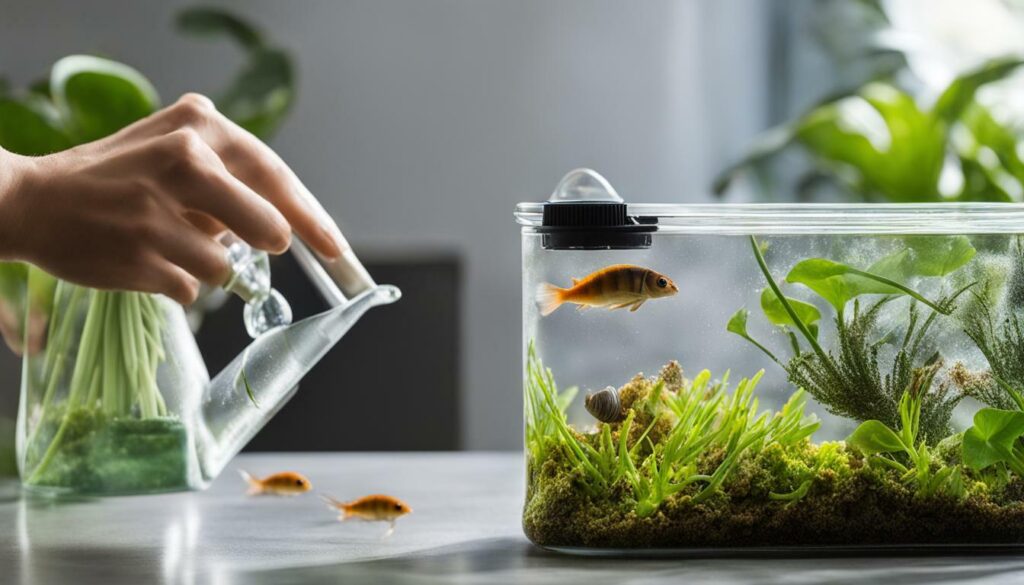
Remember, the goal of maintaining your aquatic terrarium is to create a balanced and self-sustaining ecosystem. Regular observation, care, and adjustments are the keys to success. Enjoy the beauty of your underwater world and the tranquility it brings to your space!
Creating a Closed Water TerrariumIf you’re looking for a low-maintenance aquatic terrarium option, a closed water terrarium can be a great choice. This type of setup requires minimal upkeep and can be a stunning addition to any space. All you need is a glass carafe with a cork stopper and an aquatic or semi-aquatic aquarium plant.To create your closed water terrarium, start by selecting a glass carafe with a wide opening. This will provide ample space for your plant to grow and thrive. Make sure the carafe is clean and free from any residue. Next, choose an aquatic or semi-aquatic plant that is compatible with a closed environment. Some popular options include pothos, spider plants, and peace lilies.Once you have your carafe and plant, it’s time to assemble your terrarium. Begin by adding a layer of small rocks or pebbles at the bottom of the carafe. This will act as a drainage layer to prevent water from pooling at the bottom. Next, carefully place your plant inside the carafe, making sure the roots are submerged in water. Finally, seal the carafe with a cork stopper to create a closed environment.Placement and care are key when it comes to maintaining your closed water terrarium. It’s important to place the terrarium in an area that receives indirect light, as direct sunlight can create excessive heat and harm the plant. Additionally, be mindful of the water levels in the terrarium. While closed water terrariums require very little watering, it’s important to monitor the moisture levels to ensure the plant remains healthy.Creating a closed water terrarium is a simple yet beautiful way to bring a touch of nature into your home or office space. With minimal maintenance and a stunning visual appeal, it’s no wonder this type of terrarium is growing in popularity. Whether you’re an experienced plant enthusiast or new to the world of aquatics, a closed water terrarium is a wonderful addition to any plant collection.| Pros | Cons |
|---|---|
| Low maintenance | Limited plant choices |
| Requires minimal watering | No room for fish or other aquatic animals |
| Adds a unique visual element to any space | Not suitable for all types of plants |
Placement and Care of Closed Water Terrariums
Ensuring the right placement and care for your closed water terrarium is essential to its long-term success. These unique mini ecosystems require specific conditions to thrive and flourish. Here are some key factors to consider when setting up and maintaining your closed water terrarium.
Placement: Closed water terrariums should be positioned in an area that receives indirect light. Placing them near a north-facing window or on a shaded shelf will provide the ideal lighting conditions. It’s important to avoid direct sunlight as it can cause excessive heat buildup and harm the delicate balance within the terrarium.
Watering: One of the advantages of closed water terrariums is that they require minimal watering. The self-sustaining nature of these ecosystems means that the moisture within the terrarium is recycled, creating a closed loop. However, it’s important to keep an eye on the moisture level and only water when necessary. Overwatering can lead to stagnant conditions and promote the growth of undesirable organisms.
Maintenance: Closed water terrariums are relatively low-maintenance, but regular monitoring is still necessary. Check the moisture level and adjust as needed. Remove any fallen leaves or debris to maintain a clean and healthy environment. If condensation builds up on the sides of the terrarium, it’s a sign that the humidity levels are high, and it may be necessary to temporarily remove the cork stopper to allow some airflow.
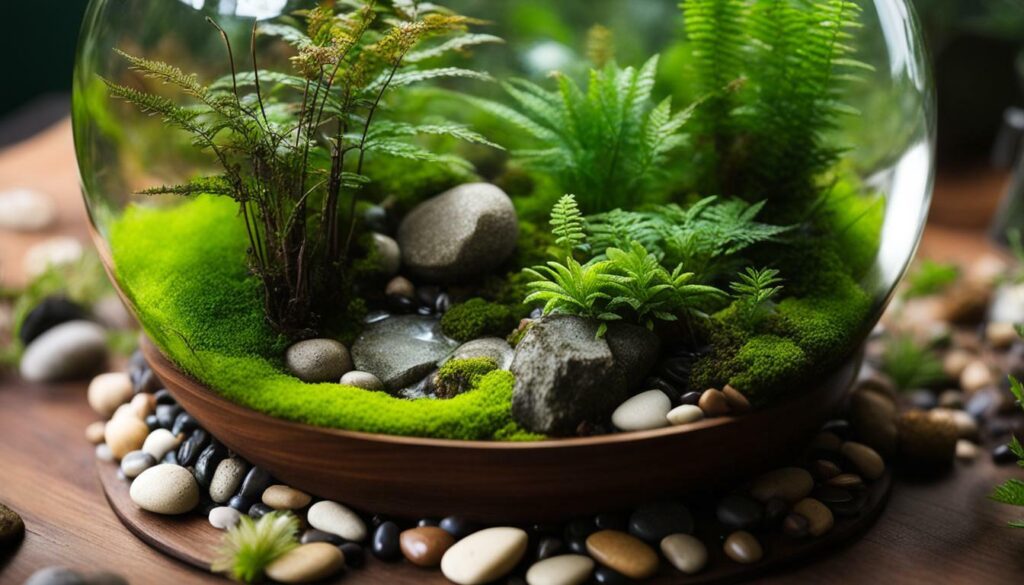
| Placement and Care of Closed Water Terrariums | |
|---|---|
| Placement | Indirect light, avoid direct sunlight |
| Watering | Minimal watering, maintain moisture level |
| Maintenance | Regular monitoring, remove debris, adjust humidity |
By following these guidelines, you can create a healthy and thriving closed water terrarium that will provide beauty and enjoyment for years to come. Remember, every closed water terrarium is a unique ecosystem, so it’s essential to pay attention to the specific needs of your terrarium and make adjustments accordingly. With the right placement and care, you can create a self-sustaining microcosm that will bring a touch of nature into your home or office.
Benefits of Aquatic Terrariums
Beyond their visual appeal, aquatic terrariums offer a range of benefits that can positively impact your overall well-being. These miniature underwater ecosystems have the power to bring a sense of calm and tranquility to any space, providing a much-needed escape from the stresses of everyday life.
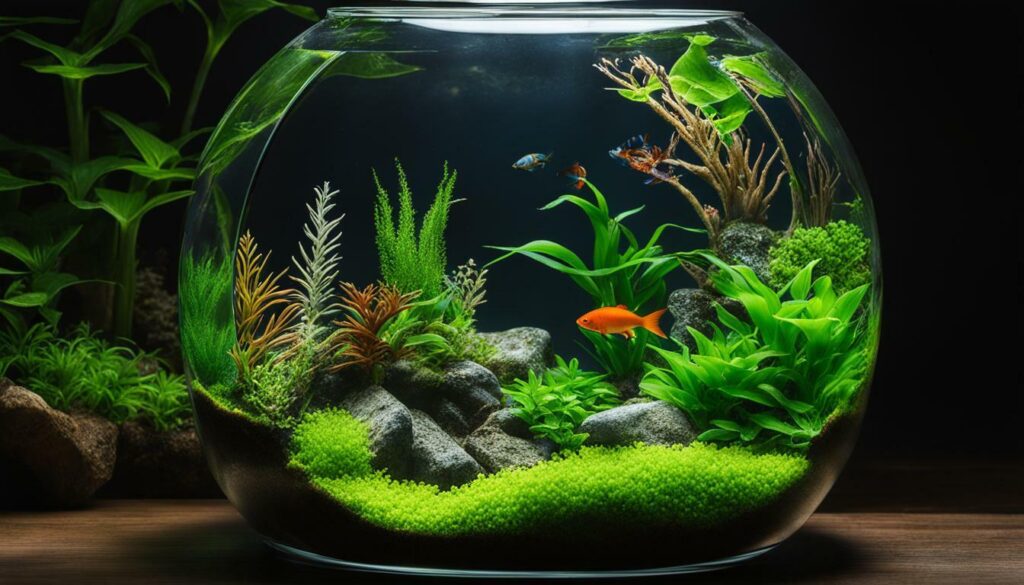
“The beauty of an aquatic terrarium lies not only in its aesthetic appeal but also in its ability to promote relaxation and reduce stress,” says renowned interior designer Jane Doe. “The serene ambiance created by the mesmerizing underwater world can be incredibly therapeutic, offering a moment of respite in our fast-paced lives.”
In addition to stress relief, aquatic terrariums also act as natural air purifiers. The plants within the terrariums absorb carbon dioxide and release oxygen, improving the air quality in the surrounding environment. This can have a positive impact on your respiratory health and overall well-being.
The aesthetic appeal of aquatic terrariums is undeniable. The vibrant colors of the fish and lush greenery of the plants can instantly uplift the mood and add a touch of natural beauty to any room. Whether you choose a tropical terrarium, a desert-themed setup, or a vivarium with a variety of plant and animal species, these captivating displays will undoubtedly become a stunning focal point in your home or office.
To fully experience the benefits of aquatic terrariums, it is important to invest time in their setup and maintenance. By creating a harmonious underwater ecosystem and taking good care of the plants and animals within, you can reap the rewards of a captivating and beneficial addition to your living or working space.
Troubleshooting Common Issues
While aquatic terrariums are generally easy to maintain, there are some common issues that you may encounter along the way. Understanding and addressing these issues promptly can help ensure the health and longevity of your underwater ecosystem. Here are some common problems you may face:
- Algae Growth: Algae can quickly become a nuisance in an aquatic terrarium, causing the water to become cloudy and the plants to suffocate. To control algae growth, ensure that your lighting solution is not too bright or left on for extended periods. Regularly clean the glass surfaces and remove any decaying plant matter. Consider adding a few algae-eating fish or snails to help keep the levels in check.
- Water Quality: Monitoring water quality is crucial to maintaining a healthy aquatic terrarium. Test the water regularly using a reliable kit to check parameters such as pH, ammonia, nitrite, and nitrate levels. If the results are outside the acceptable range, perform a partial water change to restore the balance. Avoid overfeeding your fish and be mindful of any waste buildup.
- Plant Health: Poor plant health can be a result of inadequate lighting, incorrect water parameters, or nutrient deficiencies. Ensure that your lighting solution provides the appropriate spectrum and intensity for the plants in your terrarium. Fertilize your plants as needed, following the specific requirements of each species. Regularly trim any dying or yellowing leaves to promote healthy growth.
If you encounter any of these issues, take immediate action to prevent further complications. By addressing these common problems, you can enjoy a thriving aquatic terrarium that brings beauty and tranquility to your space.
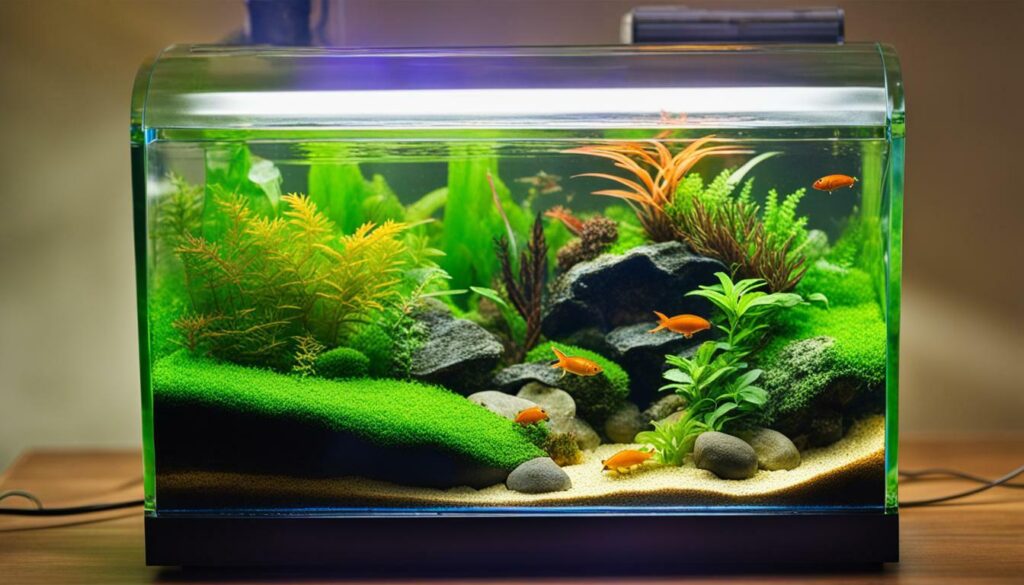
| Issue | Cause | Solution |
|---|---|---|
| Algae Growth | Bright lighting, excessive nutrients, lack of maintenance | Adjust lighting, clean surfaces, add algae-eating organisms |
| Water Quality | Imbalanced parameters, excess waste, overfeeding | Regular testing, partial water changes, proper feeding |
| Plant Health | Inadequate lighting, incorrect water parameters, nutrient deficiencies | Ensure proper lighting, test water parameters, provide suitable nutrients |
Expanding Your Aquatic Terrarium Skills
Once you’ve mastered the basics of aquatic terrariums, you can explore more advanced techniques and expand your knowledge in this fascinating hobby. One popular technique that can take your terrarium to the next level is aquascaping. Aquascaping involves creating visually stunning underwater landscapes using a combination of plants, rocks, and other decorative elements. It allows you to design and create a unique underwater ecosystem that showcases your artistic vision.
To start aquascaping, you’ll need to carefully plan your layout and consider factors such as plant placement, rock formation, and the overall theme you want to achieve. Research different aquascaping styles, such as the nature aquarium or biotope aquarium, and draw inspiration from nature to create a harmonious and balanced environment.
In addition to aquascaping, another aspect to explore is fish compatibility. Understanding the behavior and needs of different fish species will help you create a harmonious community within your aquatic terrarium. Research different fish species and their compatibility before introducing them to your tank. Consider factors such as water parameters, feeding habits, and social dynamics to ensure a peaceful and thriving environment for your fish.
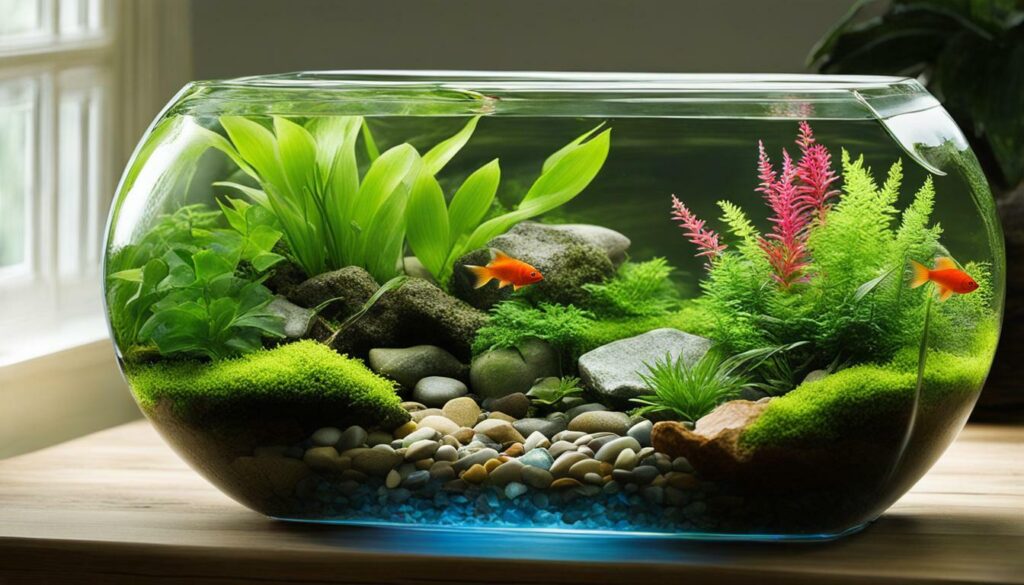
As you continue to expand your aquatic terrarium skills, don’t be afraid to experiment and try new things. Each new setup or technique will provide valuable learning experiences and opportunities for creativity. Remember to always research and prepare before making any changes to your terrarium to ensure the health and well-being of your aquatic inhabitants.
Conclusion
Creating and maintaining an aquatic terrarium can be a rewarding experience that allows you to create your own underwater ecosystem. Aquatic terrariums, also known as fish tank terrariums, offer a unique opportunity to bring the wonders of aquatic life and lush greenery into your home or office.
By following the steps outlined in this guide, you can set up a tropical terrarium with an aquarium container, background, drainage layer, substrate, hardscape elements, and a selection of fish tank terrarium plants. Choosing the right lighting solution is crucial to providing the ideal environment for your aquatic plants and underwater creatures to thrive.
Once your aquatic terrarium is set up, it requires regular maintenance to ensure the health and longevity of the ecosystem. This includes performing water changes, cleaning the tank, controlling the temperature, and providing proper care for the plants. With proper attention and care, your aquatic terrarium can become a stunning centerpiece that brings tranquility and natural beauty to any space.
For those looking for a low-maintenance option, a closed water terrarium can be created using a glass carafe, a cork stopper, and an aquatic or semi-aquatic aquarium plant. These self-sustaining ecosystems require minimal care and can add a touch of elegance to any room.
In conclusion, whether you choose to create a tropical terrarium or a closed water terrarium, the benefits of having an aquatic ecosystem in your home are numerous. From stress relief to air purification and aesthetic appeal, aquatic terrariums offer a unique and mesmerizing experience. So, dive into the world of aquatic terrariums, create your own underwater oasis, and enjoy the beauty and tranquility it brings.
Is the Maintenance for Open Terrariums Similar to that of Aquatic Terrariums?
When maintaining open terrariums expert tips, it’s important to remember that the maintenance for open terrariums is not the same as that of aquatic terrariums. Open terrariums require occasional watering and pruning, while aquatic terrariums need to be kept moist and clean to support aquatic life.
FAQ
What is an aquatic terrarium?
An aquatic terrarium is an underwater ecosystem created using a fish tank. It can be used to house various types of plants and aquatic life.
What are the different types of fish tank terrariums?
There are several options for fish tank terrariums, including a houseplant planter, a desert terrarium, a tropical terrarium, a vivarium, and a paludarium.
How do I set up a tropical terrarium?
To set up a tropical terrarium, select an aquarium container, add or create a background, create a drainage layer, add substrate, bring in hardscape elements like driftwood and rocks, add fish tank terrarium plants including ferns, vines, foliage, and moss, choose a lighting solution, and enjoy maintaining and caring for the terrarium.
What types of plants are suitable for fish tank terrariums?
Many types of plants can thrive in fish tank terrariums, including ferns, vines, foliage, and moss. These plants help create a lush and natural environment.
What is the best lighting solution for an aquatic terrarium?
The best lighting solution for an aquatic terrarium depends on the specific setup. Options include aquarium lighting and natural sunlight, which can provide the necessary light for plant growth.
How do I maintain an aquatic terrarium?
Regular maintenance for an aquatic terrarium includes water changes, cleaning, temperature control, and plant care. It’s important to monitor the water quality and ensure the plants and fish are healthy.
How do I create a closed water terrarium?
A closed water terrarium can be created using a glass carafe with a cork stopper and an aquatic or semi-aquatic aquarium plant. This type of terrarium requires no additional maintenance besides keeping it out of direct sunlight.
Where should I place a closed water terrarium?
Closed water terrariums should be placed in indirect light to prevent direct sunlight from causing excess heat and damaging the plants. They can be a beautiful addition to any indoor space.
What are the benefits of having an aquatic terrarium?
Aquatic terrariums offer several benefits, including stress relief, air purification, and aesthetic appeal. They can create a calming atmosphere and improve the overall environment of a room.
What are some common issues I may encounter with an aquatic terrarium?
Common issues with aquatic terrariums include algae growth, water quality problems, and plant health issues. Regular monitoring and proper maintenance can help prevent and address these issues.
How can I expand my aquatic terrarium skills?
If you want to further develop your skills in aquatic terrariums, you can explore advanced techniques such as aquascaping and learn about fish compatibility. These skills can enhance the beauty and complexity of your terrarium.

